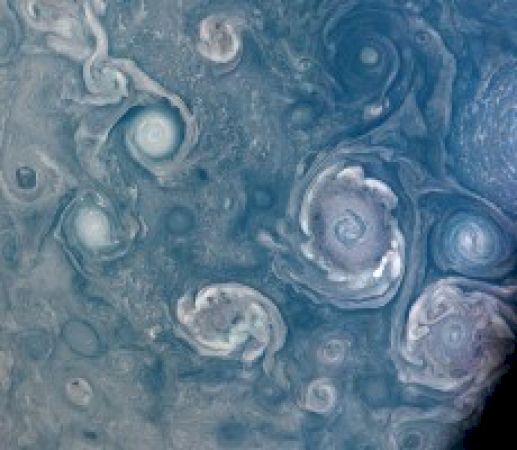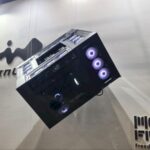
A brand new picture taken by NASA’s Juno spacecraft reveals a shocking view of vortices close to Jupiter’s north pole. The picture above of the hurricane-like spirals was shared by the Jet Propulsion Laboratory and edited by citizen scientist Brian Swift.
Jupiter is thought for its Great Red Spot, an anticyclone massive sufficient for Earth to suit inside. Recent information has recommended that the cyclones on Jupiter are hotter on high, with decrease atmospheric densities, whereas being colder on the underside, with larger densities. Anticyclones, such because the Great Red Spot, are colder on the high and hotter on the backside. However, it’s a picture taken of the planet’s north pole that has the eye of scientists in the intervening time.
According to the Jet Propulsion Laboratory (JPL). these highly effective storms on the north pole could be 30 miles (50 kilometers) in top and lots of of miles throughout. Scientists consider that by determining how they type, they will higher perceive Jupiter’s environment, in addition to the fluid dynamics and chemistry that make up the remainder of the planet’s atmospheric actions.
In specific, scientists are wanting to raised perceive the vortices’ shapes, sizes, and colours. As an instance, cyclones which spin counter-clockwise within the northern hemisphere and clockwise within the southern, and anti-cyclones which spin clockwise within the northern and counter-clockwise within the southern hemisphere, showcase very completely different colours and shapes.
One means they’re trying into understanding this higher, is by taking a look at how these cyclones change over time. In the picture above, cyclones of Jupiter’s south pole could be seen in 2016 after which once more in 2021. The pictures have been taken utilizing Juno’s Jovian Infrared Auroral Mapper (JIRAM). In each pictures, 5 cyclones are organized as a pentagon, with a sixth cyclone within the heart (south pole).
One thrilling factor to notice is that anybody will help with this analysis. A NASA citizen science mission, Jovian Vortex Hunter, is in search of volunteers from the general public to identify and assist categorize vortices and different atmospheric phenomena. There isn’t any specialised coaching or software program wanted, and could be finished by anybody who has entry to a cellphone or laptop computer. If you want to partake on this analysis, you’ll find out extra by visiting Zooniverse.org.
Top Image Credit: NASA/JPL









